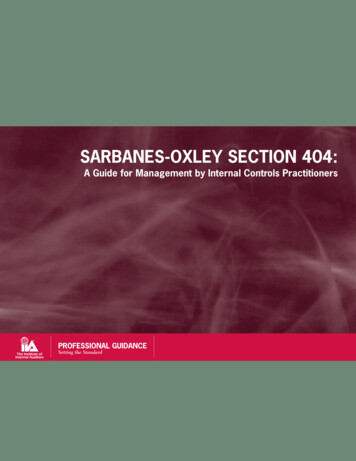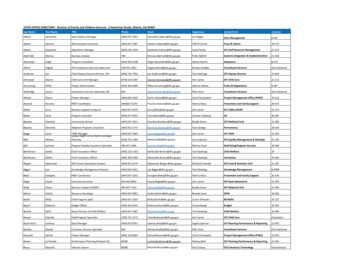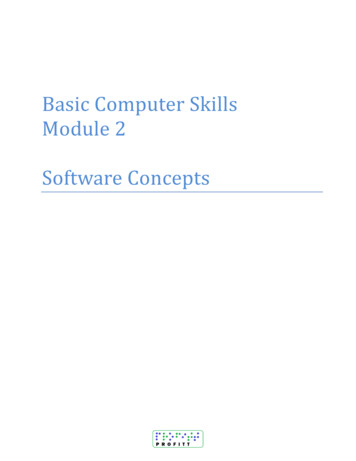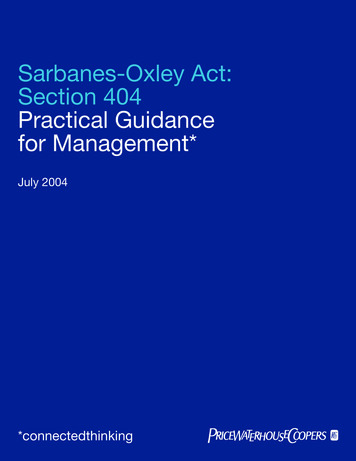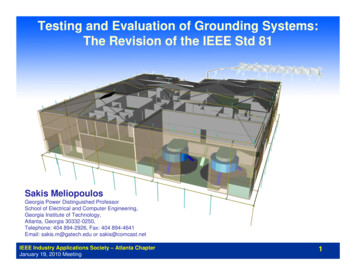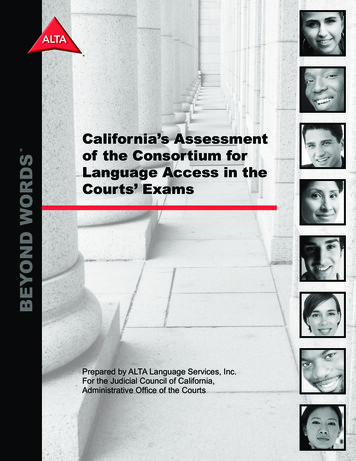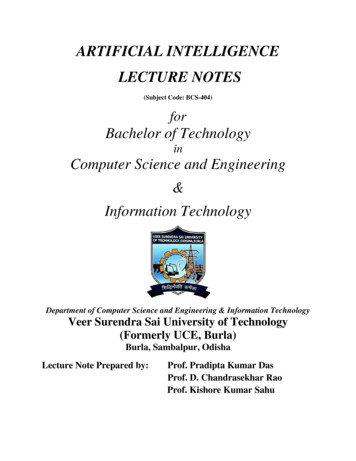
Transcription
ARTIFICIAL INTELLIGENCELECTURE NOTES(Subject Code: BCS-404)forBachelor of TechnologyinComputer Science and Engineering&Information TechnologyDepartment of Computer Science and Engineering & Information TechnologyVeer Surendra Sai University of Technology(Formerly UCE, Burla)Burla, Sambalpur, OdishaLecture Note Prepared by:Prof. Pradipta Kumar DasProf. D. Chandrasekhar RaoProf. Kishore Kumar Sahu
DISCLAIMERThis document does not claim any originality and cannot beused as a substitute for prescribed textbooks. The informationpresented here is merely a collection by the committee membersfor their respective teaching assignments. Various sources asmentioned at the end of the document as well as freely availablematerial from internet were consulted for preparing thisdocument. The ownership of the information lies with therespective authors or institutions.
BCS-404 ARTIFICIAL INTELLIGENCE (3-1-0) Cr.-04Module - IFormalized symbolic logic: Propositional logic-first order predicate logic, wff conversionto clausal form, inference rules, the resolution principle, Dealing with inconsistencies anduncertainties, fuzzy logic.Module - IIProbabilistic Reasoning Structured knowledge, graphs, frames and related structures,Knowledge organization and manipulation.Module – IIIMatching Techniques, Knowledge organizations, Management.Module - IVNatural Language processing, Pattern recognition, expert systems.Text Book:1. Artificial Intelligence, Dan W Patterson, Prentice Hall of India (1999) Chapter-4,5,7,9,10,11,12,13,15.Reference Books:1. Artificial Intelligence, Nils J.Nilsson, ELSEVIER.2. E.Rich and K.Knight, Artificial Intelligence, - TMH
Overview of Artificial IntelligenceWhat is AI ? Artificial Intelligence (AI) is a branch of Science which deals with helping machinesfind solutions to complex problems in a more human-like fashion. This generally involves borrowing characteristics from human intelligence, andapplying them as algorithms in a computer friendly way. A more or less flexible or efficient approach can be taken depending on therequirements established, which influences how artificial the intelligent behaviorappears Artificial intelligence can be viewed from a variety of perspectives. Fromtheperspectiveofintelligenceartificial intelligence is making machines "intelligent" -- acting as we wouldexpect people to act.o The inability to distinguish computer responses from human responsesis called the Turing test.o Intelligence requires knowledgeo Expert problem solving - restricting domain to allow includingsignificant relevant knowledge From a business perspective AI is a set of very powerful tools, andmethodologies for using those tools to solve business problems. From a programming perspective, AI includes the study of symbolicprogramming, problem solving, and search.o Typically AI programs focus on symbols rather than numericprocessing.o Problem solving - achieve goals.o Search - seldom access a solution directly. Search may include avariety of techniques.o AI programming languages include:–LISP, developed in the 1950s, is the early programming languagestrongly associated with AI. LISP is a functional programming language withprocedural extensions. LISP (LISt Processor) was specifically designed for
processing heterogeneous lists -- typically a list of symbols. Features of LISPare run- time type checking, higher order functions (functions that have otherfunctions as parameters), automatic memory management (garbage collection)and an interactive environment.–The second language strongly associated with AI is PROLOG.PROLOG was developed in the 1970s. PROLOG is based on first order logic.PROLOG is declarative in nature and has facilities for explicitly limiting thesearch space.–Object-oriented languages are a class of languages more recently usedfor AI programming. Important features of object-oriented languages include:concepts of objects and messages, objects bundle data and methods formanipulating the data, sender specifies what is to be done receiver decideshow to do it, inheritance (object hierarchy where objects inherit the attributesof the more general class of objects). Examples of object-oriented languagesare Smalltalk, Objective C, C . Object oriented extensions to LISP (CLOS Common LISP Object System) and PROLOG (L&O - Logic & Objects) arealso used. Artificial Intelligence is a new electronic machine that stores large amount ofinformation and process it at very high speed The computer is interrogated by a human via a teletype It passes if the human cannottell if there is a computer or human at the other end The ability to solve problems It is the science and engineering of making intelligent machines, especially intelligentcomputer programs. It is related to the similar task of using computers to understandhuman intelligenceImportance of AI Game PlayingYou can buy machines that can play master level chess for a few hundred dollars.There is some AI in them, but they play well against people mainly through bruteforce computation--looking at hundreds of thousands of positions. To beat a worldchampion by brute force and known reliable heuristics requires being able to look at200 million positions per second. Speech Recognition
In the 1990s, computer speech recognition reached a practical level for limitedpurposes. Thus United Airlines has replaced its keyboard tree for flight informationby a system using speech recognition of flight numbers and city names. It is quiteconvenient. On the other hand, while it is possible to instruct some computers usingspeech, most users have gone back to the keyboard and the mouse as still moreconvenient. Understanding Natural LanguageJust getting a sequence of words into a computer is not enough. Parsing sentences isnot enough either. The computer has to be provided with an understanding of thedomain the text is about, and this is presently possible only for very limited domains. Computer VisionThe world is composed of three-dimensional objects, but the inputs to the human eyeand computers' TV cameras are two dimensional. Some useful programs can worksolely in two dimensions, but full computer vision requires partial three-dimensionalinformation that is not just a set of two-dimensional views. At present there are onlylimited ways of representing three-dimensional information directly, and they are notas good as what humans evidently use. Expert SystemsA knowledge engineer'' interviews experts in a certain domain and tries to embodytheir knowledge in a computer program for carrying out some task. How well thisworks depends on whether the intellectual mechanisms required for the task arewithin the present state of AI. When this turned out not to be so, there were manydisappointing results. One of the first expert systems was MYCIN in 1974, whichdiagnosed bacterial infections of the blood and suggested treatments. It did better thanmedical students or practicing doctors, provided its limitations were observed.Namely, its ontology included bacteria, symptoms, and treatments and did not includepatients, doctors, hospitals, death, recovery, and events occurring in time. Itsinteractions depended on a single patient being considered. Since the expertsconsulted by the knowledge engineers knew about patients, doctors, death, recovery,etc., it is clear that the knowledge engineers forced what the experts told them into apredetermined framework. The usefulness of current expert systems depends on theirusers having common sense.
Heuristic ClassificationOne of the most feasible kinds of expert system given the present knowledge of AI isto put some information in one of a fixed set of categories using several sources ofinformation. An example is advising whether to accept a proposed credit cardpurchase. Information is available about the owner of the credit card, his record ofpayment and also about the item he is buying and about the establishment from whichhe is buying it (e.g., about whether there have been previous credit card frauds at thisestablishment). The applications of AI are shown in Fig 1.1: Consumer Marketingo Have you ever used any kind of credit/ATM/store card while shopping?o if so, you have very likely been “input” to an AI algorithmo All of this information is recorded digitallyo Companies like Nielsen gather this information weekly and search forpatterns–general changes in consumer behavior–tracking responses to new products–identifying customer segments: targeted marketing, e.g., they findout that consumers with sports cars who buy textbooks respondwell to offers of new credit cards.o Algorithms (“data mining”) search data for patterns based on mathematicaltheories of learning Identification Technologieso ID cards e.g., ATM cardso can be a nuisance and security risk: cards can be lost, stolen, passwordsforgotten, etco Biometric Identification, walk up to a locked door–Camera–Fingerprint device–Microphone–Computer uses biometric signature for identification–Face, eyes, fingerprints, voice pattern
–This works by comparing data from person at door with storedlibrary–Learning algorithms can learn the matching process by analyzing alarge library database off-line, can improve its performance. Intrusion Detectiono Computer security - we each have specific patterns of computer use timesof day, lengths of sessions, command used, sequence of commands, etc–would like to learn the “signature” of each authorized user–can identify non-authorized userso How can the program automatically identify users?–record user’s commands and time intervals–characterize the patterns for each user–model the variability in these patterns–classify (online) any new user by similarity to stored patterns Machine Translationo Language problems in international business–e.g., at a meeting of Japanese, Korean, Vietnamese and Swedishinvestors, no common language–If you are shipping your software manuals to 127 countries, thesolution is ; hire translators to translate–would be much cheaper if a machine could do this!o How hard is automated translation–very difficult!–e.g., English to Russian–not only must the words be translated, but their meaning also!
Fig : Application areas of AIEarly work in AI “Artificial Intelligence (AI) is the part of computer science concerned with designingintelligent computer systems, that is, systems that exhibit characteristics we associatewith intelligence in human behaviour – understanding language, learning, reasoning,solving problems, and so on.” Scientific Goal To determine which ideas about knowledge representation, learning,rule systems, search, and so on, explain various sorts of real intelligence. Engineering GoalTo solve real world problems using AI techniques such asknowledge representation, learning, rule systems, search, and so on. Traditionally, computer scientists and engineers have been more interested in theengineering goal, while psychologists, philosophers and cognitive scientists have beenmore interested in the scientific goal. The Roots - Artificial Intelligence has identifiable roots in a number of olderdisciplines, particularly: Philosophy Logic/Mathematics Computation
Psychology/Cognitive Science Biology/Neuroscience Evolution There is inevitably much overlap, e.g. between philosophy and logic, or betweenmathematics and computation. By looking at each of these in turn, we can gain abetter understanding of their role in AI, and how these underlying disciplines havedeveloped to play that role. Philosophy 400 BC Socrates asks for an algorithm to distinguish piety from non-piety. 350 BCAristotle formulated different styles of deductive reasoning, whichcould mechanically generate conclusions from initial premises, e.g. Modus PonensIfA?BandIf A implies BAthenBandA is truethenB is true when it’s raining youget wet and it’s raining then you get wet 1596 – 1650Rene Descartes idea of mind-body dualism – part of the mind isexempt from physical laws. 1646 – 1716 Wilhelm Leibnitz was one of the first to take the materialist positionwhich holds that the mind operates by ordinary physical processes – this has theimplication that mental processes can potentially be carried out by machines. Logic/Mathematics EarlStanhope’s Logic Demonstrator was a machine that was able to solvesyllogisms, numerical problems in a logical form, and elementary questions ofprobability. 1815 – 1864 George Boole introduced his formal language for making logicalinference in 1847 – Boolean algebra. 1848 – 1925Gottlob Frege produced a logic that is essentially the first-orderlogic that today forms the most basic knowledge representation system. 1906 – 1978 Kurt Gödel showed in 1931 that there are limits to what logic cando. His Incompleteness Theorem showed that in any formal logic powerfulenough to describe the properties of natural numbers, there are true statementswhose truth cannot be established by any algorithm.
1995 Roger Penrose tries to prove the human mind has non-computablecapabilities. Computation 1869 William Jevon’s Logic Machine could handle Boolean Algebra and VennDiagrams, and was able to solve logical problems faster than human beings. 1912 – 1954Alan Turing tried to characterise exactly which functions arecapable of being computed. Unfortunately it is difficult to give the notion ofcomputation a formal definition. However, the Church-Turing thesis, which statesthat a Turing machine is capable of computing any computable function, isgenerally accepted as providing a sufficient definition. Turing also showed thatthere were some functions which no Turing machine can compute (e.g. HaltingProblem). 1903 – 1957John von Neumann proposed the von Neuman architecture whichallows a description of computation that is independent of the particularrealisation of the computer. 1960sTwo important concepts emerged: Intractability (when solution timegrows atleast exponentially) and Reduction (to ‘easier’ problems). Psychology / Cognitive Science Modern Psychology / Cognitive Psychology / Cognitive Science is the sciencewhich studies how the mind operates, how we behave, and how our brains processinformation. Language is an important part of human intelligence. Much of the early work onknowledge representation was tied to language and informed by research intolinguistics. It is natural for us to try to use our understanding of how human (and otheranimal) brains lead to intelligent behavior in our quest to build artificial intelligentsystems. Conversely, it makes sense to explore the properties of artificial systems(computer models/simulations) to test our hypotheses concerning human systems. Many sub-fields of AI are simultaneously building models of how the humansystem operates, and artificial systems for solving real world problems, and areallowing useful ideas to transfer between them. Biology / Neuroscience
Our brains (which give rise to our intelligence) are made up of tens of billions ofneurons, each connected to hundreds or thousands of other neurons. Each neuron is a simple processing device (e.g. just firing or not firing dependingon the total amount of activity feeding into it). However, large networks ofneurons are extremely powerful computational devices that can learn how best tooperate. The field of Connectionism or Neural Networks attempts to build artificialsystems based on simplified networks of simplified artificial neurons. The aim is to build powerful AI systems, as well as models of various humanabilities. Neural networks work at a sub-symbolic level, whereas much of conscious humanreasoning appears to operate at a symbolic level. Artificial neural networks perform well at many simple tasks, and provide goodmodels of many human abilities. However, there are many tasks that they are notso good at, and other approaches seem more promising in those areas. Evolution One advantage humans have over current machines/computers is that they have along evolutionary history. Charles Darwin (1809 – 1882) is famous for his work on evolution by naturalselection. The idea is that fitter individuals will naturally tend to live longer andproduce more children, and hence after many generations a population willautomatically emerge with good innate properties. This has resulted in brains that have much structure, or even knowledge, built in atbirth. This gives them at the advantage over simple artificial neural network systemsthat have to learn everything. Computers are finally becoming powerful enough that we can simulate evolutionand evolve good AI systems. We can now even evolve systems (e.g. neural networks) so that they are good atlearning. A related field called genetic programming has had some success in evolvingprograms, rather than programming them by hand. Sub-fields of Artificial Intelligence
Neural Networks – e.g. brain modelling, time series prediction, classification Evolutionary Computation – e.g. genetic algorithms, genetic programming Vision – e.g. object recognition, image understanding Robotics – e.g. intelligent control, autonomous exploration Expert Systems – e.g. decision support systems, teaching systems Speech Processing– e.g. speech recognition and production Natural Language Processing – e.g. machine translation Planning – e.g. scheduling, game playing Machine Learning – e.g. decision tree learning, version space learning Speech Processing As well as trying to understand human systems, there are also numerous realworld applications: speech recognition for dictation systems and voice activatedcontrol; speech production for automated announcements and computer interfaces. How do we get from sound waves to text streams and vice-versa? Natural Language Processing For example, machine understanding and translation of simple sentences: Planning Planning refers to the process of choosing/computing the correct sequence of stepsto solve a given problem. To do this we need some convenient representation of the problem domain. Wecan define states in some formal language, such as a subset of predicate logic, or aseries of rules. A plan can then be seen as a sequence of operations that transform the initial stateinto the goal state, i.e. the problem solution. Typically we will use some kind ofsearch algorithm to find a good plan. Common Techniques Even apparently radically different AI systems (such as rule based expert systemsand neural networks) have many common techniques. Four important ones are:
o Knowledge Representation:Knowledge needs to be representedsomehow – perhaps as a series of if-then rules, as a frame based system, asa semantic network, or in the connection weights of an artificial neuralnetwork.o Learning:Automatically building up knowledge from the environment –such as acquiring the rules for a rule based expert system, or determiningthe appropriate connection weights in an artificial neural network.o Rule Systems: These could be explicitly built into an expert system by aknowledge engineer, or implicit in the connection weights learnt by aneural network.o Search: This can take many forms – perhaps searching for a sequence ofstates that leads quickly to a problem solution, or searching for a good setof connection weights for a neural network by minimizing a fitnessfunction.AI and related fields Logical AIWhat a program knows about the world in general the facts of the specific situation inwhich it must act, and its goals are all represented by sentences of some mathematicallogical language. The program decides what to do by inferring that certain actions areappropriate for achieving its goals. SearchAI programs often examine large numbers of possibilities, e.g. moves in a chess gameor inferences by a theorem proving program. Discoveries are continually made abouthow to do this more efficiently in various domains. Pattern RecognitionWhen a program makes observations of some kind, it is often programmed tocompare what it sees with a pattern. For example, a vision program may try to matcha pattern of eyes and a nose in a scene in order to find a face. More complex patterns,e.g. in a natural language text, in a chess position, or in the history of some event arealso studied.
RepresentationFacts about the world have to be represented in some way. Usually languages ofmathematical logic are used. InferenceFrom some facts, others can be inferred. Mathematical logical deduction is adequatefor some purposes, but new methods of non-monotonic inference have been added tologic since the 1970s. The simplest kind of non-monotonic reasoning is defaultreasoning in which a conclusion is to be inferred by default, but the conclusion can bewithdrawn if there is evidence to the contrary. For example, when we hear of a bird,we man infer that it can fly, but this conclusion can be reversed when we hear that itis a penguin. It is the possibility that a conclusion may have to be withdrawn thatconstitutes the non-monotonic character of the reasoning. Ordinary logical reasoningis monotonic in that the set of conclusions that can the drawn from a set of premises isa monotonic increasing function of the premises. Common sense knowledge and reasoningThis is the area in which AI is farthest from human-level, in spite of the fact that it hasbeen an active research area since the 1950s. While there has been considerableprogress, e.g. in developing systems of non-monotonic reasoning and theories ofaction, yet more new ideas are needed. Learning from experiencePrograms do that. The approaches to AI based on connectionism and neural netsspecialize in that. There is also learning of laws expressed in logic. Programs can onlylearn what facts or behaviors their formalisms can represent, and unfortunatelylearning systems are almost all based on very limited abilities to representinformation. PlanningPlanning programs start with general facts about the world (especially facts about theeffects of actions), facts about the particular situation and a statement of a goal. Fromthese, they generate a strategy for achieving the goal. In the most common cases, thestrategy is just a sequence of actions. Epistemology
This is a study of the kinds of knowledge that are required for solving problems in theworld. OntologyOntology is the study of the kinds of things that exist. In AI, the programs andsentences deal with various kinds of objects, and we study what these kinds are andwhat their basic properties are. Emphasis on ontology begins in the 1990s. HeuristicsA heuristic is a way of trying to discover something or an idea imbedded in aprogram. The term is used variously in AI. Heuristic functions are used in someapproaches to search to measure how far a node in a search tree seems to be from agoal. Heuristic predicates that compare two nodes in a search tree to see if one isbetter than the other, i.e. constitutes an advance toward the goal, may be more useful. Genetic ProgrammingGenetic programming is a technique for getting programs to solve a task by matingrandom Lisp programs and selecting fittest in millions of generations.Search and Control Strategies:Problem solving is an important aspect of Artificial Intelligence. A problem can beconsidered to consist of a goal and a set of actions that can be taken to lead to the goal. Atany given time, we consider the state of the search space to represent where we have reachedas a result of the actions we have applied so far. For example, consider the problem oflooking for a contact lens on a football field. The initial state is how we start out, which is tosay we know that the lens is somewhere on the field, but we don’t know where. If we use therepresentation where we examine the field in units of one square foot, then our first actionmight be to examine the square in the top-left corner of the field. If we do not find the lensthere, we could consider the state now to be that we have examined the top-left square andhave not found the lens. After a number of actions, the state might be that we have examined500 squares, and we have now just found the lens in the last square we examined. This is agoal state because it satisfies the goal that we had of finding a contact lens.Search is a method that can be used by computers to examine a problem space likethis in order to find a goal. Often, we want to find the goal as quickly as possible or withoutusing too many resources. A problem space can also be considered to be a search space
because in order to solve the problem, we will search the space for a goal state.We willcontinue to use the term search space to describe this concept. In this chapter, we will look ata number of methods for examining a search space. These methods are called searchmethods. The Importance of Search in AI It has already become clear that many of the tasks underlying AI can bephrased in terms of a search for the solution to the problem at hand. Many goal based agents are essentially problem solving agents which mustdecide what to do by searching for a sequence of actions that lead to theirsolutions. For production systems, we have seen the need to search for a sequence of ruleapplications that lead to the required fact or action. For neural network systems, we need to search for the set of connectionweights that will result in the required input to output mapping. Which search algorithm one should use will generally depend on the problemdomain? There are four important factors to consider: Completeness – Is a solution guaranteed to be found if at least one solutionexists? Optimality – Is the solution found guaranteed to be the best (or lowest cost)solution if there exists more than one solution? Time Complexity – The upper bound on the time required to find a solution,as a function of the complexity of the problem. Space Complexity – The upper bound on the storage space (memory) requiredat any point during the search, as a function of the complexity of the problem.Preliminary concepts Two varieties of space-for-time algorithms: Input enhancement — preprocess the input (or its part) to store some info tobe used later in solving the problemo Counting for sortingo String searching algorithms Prestructuring — preprocess the input to make accessing its elements easiero Hashing
o Indexing schemes (e.g., B-trees) State Space Representations: The state space is simply the space of all possiblestates, or configurations, that our system may be in. Generally, of course, we prefer towork with some convenient representation of that search space. There are two components to the representation of state spaces: Static States Transitions between States State Space Graphs: If the number of possible states of the system is small enough,we can represent all of them, along with the transitions between them, in a state spacegraph, e.g. Routes through State Space: Our general aim is to search for a route, or sequence oftransitions, through the state space graph from our initial state to a goal state. Sometimes there will be more than one possible goal state. We define a goal test todetermine if a goal state has been achieved. The solution can be represented as a sequence of link labels (or transitions) on thestate space graph. Note that the labels depend on the direction moved along the link. Sometimes there may be more than one path to a goal state, and we may want to findthe optimal (best possible) path. We can define link costs and path costs formeasuring the cost of going along a particular path, e.g. the path cost may just equalthe number of links, or could be the sum of individual link costs.
For most realistic problems, the state space graph will be too large for us to hold all ofit explicitly in memory at any one time. Search Trees: It is helpful to think of the search process as building up a search treeof routes through the state space graph. The root of the search tree is the search nodecorresponding to the initial state. The leaf nodes correspond either to states that have not yet been expanded, or to statesthat generated no further nodes when expanded. At each step, the search algorithm chooses a new unexpanded leaf node to expand.The different search strategies essentially correspond to the different algorithms onecan use to select which is the next mode to be expanded at each stage.Examples of search problems Traveling Salesman Problem: Given n cit ies wit h known distances between eachpair, find the shortest tour that passes through all the cit ies exact ly once beforereturning to the starting cit y. A lower bound on the length l of any tour can be computed as fo llows For each cit y i, 1 i n, find the sum si of the distances from city i to the twonearest cities. Compute the sum s of these n numbers. Divide the result by 2 and round up the result to the nearest integerlb s / 2 The lower bound for the graph shown in the Fig 5.1 can be computed as follows:
lb [(1 3) (3 6) (1 2) (3 4) (2 3)] / 2 14. For any subset of tours that must include particular edges of a given graph, the lowerbound can be modified accordingly. E.g.: For all the Hamiltonian circuits of the graphthat must include edge (a, d), the lower bound can be computed as follows:lb [(1 5) (3 6) (1 2) (3 5) (2 3)] / 2 16. Applying the branch-and-bound algorithm, with the bounding function lb s / 2, tofind the shortest Hamiltonian circuit for the given graph, we obtain the state-spacetree as shown below: To reduce the amount of potential work, we take advantage of the following twoobservations: We can consider only tours that start with a. Since the graph is undirected, we can generate only tours in which b is visitedbefore c. In addition, after visiting n – 1 cities, a tour has no choice but to visit the remainingunvisited city and return to the starting one is shown in the Fig 5.2
Root node includes only the starting vertex a with a lower bound oflb [(1 3) (3 6) (1
E.Rich and K.Knight, Artificial Intelligence, - TMH . Overview of Artificial Intelligence What is AI ? Artificial Intelligence (AI) is a branch of Science which deals with helping machines find solutions to complex problems in a more human-like fashion. This generally involves borrowing chara



